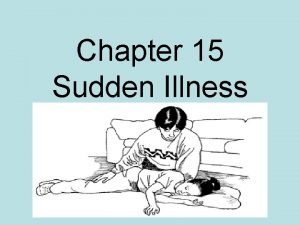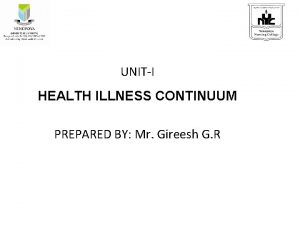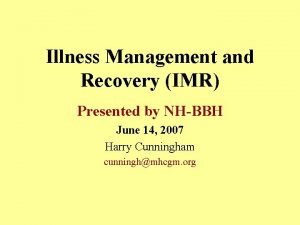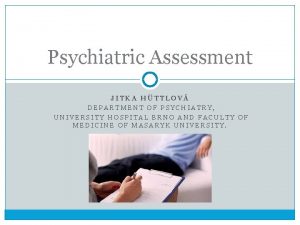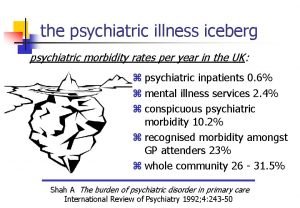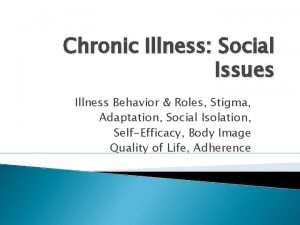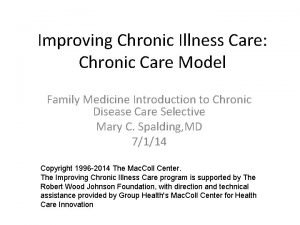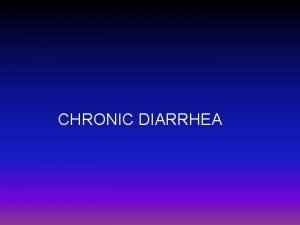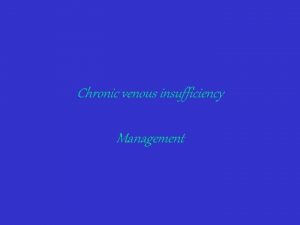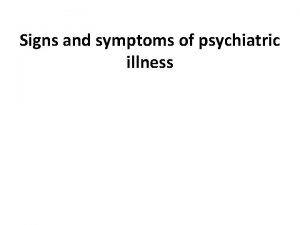The Psychiatric Medical Home and Chronic Psychiatric Illness





















- Slides: 21

The Psychiatric Medical Home and Chronic Psychiatric Illness Edward Kim, MD, MBA Associate Director, Health Economics and Outcomes Research Bristol-Myers Squibb Company

Overview The challenge of chronic psychiatric illness n Structural barriers to effective management n Psychiatric medical home case study n Lessons learned/future directions n

The Problem People with serious mental illness die approximately 25 years earlier than the general population. n Medical co-morbidity is common in this population n Care coordination is complex n

Increased Mortality From Medical Causes in Mental Illness n Increased risk of death from medical causes in schizophrenia and 20% (10 -15 yrs) shorter lifespan 1 n Bipolar and unipolar affective disorders also associated with higher SMRs from medical causes 2 – 1. 9 males/2. 1 females in bipolar disorder – 1. 5 males/1. 6 females in unipolar disorder n Cardiovascular mortality in schizophrenia increased from 1976 -1995, with greatest increase in SMRs in men from 1991 -19953 SMR = standardized mortality ratio (observed/expected deaths). 1. Harris et al. Br J Psychiatry. 1998; 173: 11. Newman SC, Bland RC. Can J Psych. 1991; 36: 239 -245. 2. Osby et al. Arch Gen Psychiatry. 2001; 58: 844 -850. 3. Osby et al. BMJ. 2000; 321: 483 -484.

Multi-State Study Mortality Data: Years of Potential Life Lost n Compared to the general population, persons with major mental illness typically lose more than 25 years of normal life span Colton CW, Manderscheid RW. Prev Chronic Dis [serial online] 2006 Apr [date cited]. Available from: URL: http: //www. cdc. gov/pcd/issues/2006/apr/05_0180. htm

Schizophrenia: Natural Causes of Death n Higher standardized mortality rates than the general population from: – – n Diabetes Cardiovascular disease Respiratory disease Infectious diseases 2. 7 x 2. 3 x 3. 2 x 3. 4 x Cardiovascular disease associated with the largest number of deaths – 2. 3 X the largest cause of death in the general population Osby U et al. Schizophr Res. 2000; 45: 21 -28.

Contributory Factors Lifestyle n Medications n Surveillance n

Cardiovascular Disease (CVD) Risk Factors Modifiable Risk Factors Estimated Prevalence and Relative Risk (RR) Schizophrenia Bipolar Disorder Obesity 45– 55%, 1. 5 -2 X RR 1 26%5 Smoking 50– 80%, 2 -3 X RR 2 55%6 Diabetes 10– 14%, 2 X RR 3 10%7 Hypertension ≥ 18%4 15%5 Dyslipidemia Up to 5 X RR 8 1. Davidson S, et al. Aust N Z J Psychiatry. 2001; 35: 196 -202. 2. Allison DB, et al. J Clin Psychiatry. 1999; 60: 215 -220. 3. Dixon L, et al. J Nerv Ment Dis. 1999; 187: 496 -502. 4. Herran A, et al. Schizophr Res. 2000; 41: 373 -381. 5. Me. Elroy SL, et al. J Clin Psychiatry. 2002; 63: 207 -213. 6. Ucok A, et al. Psychiatry Clin Neurosci. 2004; 58: 434 -437. 7. Cassidy F, et al. Am J Psychiatry. 1999; 156: 1417 -1420. 8. Allebeck. Schizophr Bull. 1999; 15(1)81 -89.

Impact of mental illness on diabetes management Depression Anxiety Psychosis Mania Substance use disorder Personality disorder Odds ratio for: 0. 8 1. 0 1. 2 1. 4 1. 6 No Hb. A test done No LDL test done No Eye examination done No Monitoring Poor glycemic control Poor lipemic control 313, 586 Veteran Health Authority patients with diabetes 76, 799 (25%) had mental health conditions (1999) Frayne et al. Arch Intern Med. 2005; 165: 2631 -2638


“Every system is perfectly designed to achieve exactly the results it gets. ” (Berwick, 1998)

Summary SPMI population is at high risk for medical morbidity and mortality n Management is suboptimal n

Barriers to Effective Management Healthcare System n Provider n Patient n

The MH/SA “System” Segregated from PH system n Diverse care settings n Diverse provider base n Lack of confidence/priority with medical conditions n

System Level Barriers MHS-PHS Communication ▪ HIPAA ▪ Geographic/temporal separation ▪ Role definition ▪ Organizational culture PHP MHP-Patient Interactions ▪ Awareness of needs ▪ Role definition ▪ Patient cognitive barriers ▪ MHP health literacy ▪ MHP knowledge of PH system Structural and functional differences between MH and PH systems reduce effectiveness and quality of clinical management Patient PCP-Patient Interactions ▪ PCP Awareness of needs ▪ Patient cognitive barriers ▪ Patient health literacy ▪ Stigma ▪ PCP knowledge of MH system

Access to Medical Care of People with SPMI n SPMI clients have difficulties accessing primary care providers – Less likely to report symptoms – Cognitive impairment, social isolation reduce help-seeking behaviors – Cognitive, social impairment impedes effective navigation of health care system n Accessing and using primary care is more difficult Jeste DV, Gladsjo JA, Landamer LA, Lacro JP. Medical comorbidity in schizophrenia. Schizophrenia Bull 1996; 22: 413 -427 Goldman LS. Medical illness in patients with schizophrenia. J Clin Psych 1999; 60 (suppl 21): 10 -15

Management Strategies Care Coordination n Integrated Care n

Collaborative Care Model Level 1 – Preventive/screening n Level 2 – PCP/extenders provide care n Level 3 – Specialist consultation n Level 4 – Specialist referral n Katon et al (2001) Gen Hosp Psychiatry 23: 138 -144

UMDNJ Pilot n Dually-trained psychiatrist/FP – Direct patient care – Physician of Protocol n Dually-trained nurse practitioners – Direct patient care – Education groups – Liaison with external providers (MH, PH)

UMDNJ Pilot MHS-PHS Communication ▪ Collaboration in treatment team meetings ▪ Consultation for routine care ▪ Referral for complex cases Full cross-functional integration on-site facilitates optimal management PCP/NP MHP-Patient Interactions ▪ Focus on MH management ▪ Integrate PH issues into care plan PCP-Patient Interactions ▪ Focused consultation ▪ NP follow-up Patient

Conclusions Co-morbidity and increased mortality are the norm n Multiple barriers prevent effective care n Integrated care is clinically, operationally feasible n Funding pathway is a major barrier n
 Improving chronic illness care model
Improving chronic illness care model Legal issues in psychiatric nursing
Legal issues in psychiatric nursing Apa arti homecare
Apa arti homecare Perbedaan home care dan home visit
Perbedaan home care dan home visit Mobile home parks for sale in sc
Mobile home parks for sale in sc Unit 3 home sweet home
Unit 3 home sweet home Come home come home jesus is calling
Come home come home jesus is calling New mobile home sales oak springs mobile home community
New mobile home sales oak springs mobile home community Let's go to my house
Let's go to my house André fougeron
André fougeron She said that, home economics stands for the ideal home.
She said that, home economics stands for the ideal home. Home sweet home survive prayer
Home sweet home survive prayer Hepburn osteometric board
Hepburn osteometric board Chapter 20 mental health and mental illness
Chapter 20 mental health and mental illness Name 5 sudden illness.
Name 5 sudden illness. Health illness continuum model
Health illness continuum model Illness and wellness continuum
Illness and wellness continuum Health illness continuum
Health illness continuum Illness management and recovery worksheet
Illness management and recovery worksheet Mental health definition in nursing
Mental health definition in nursing Assessment skills
Assessment skills Nursing rationale examples
Nursing rationale examples














